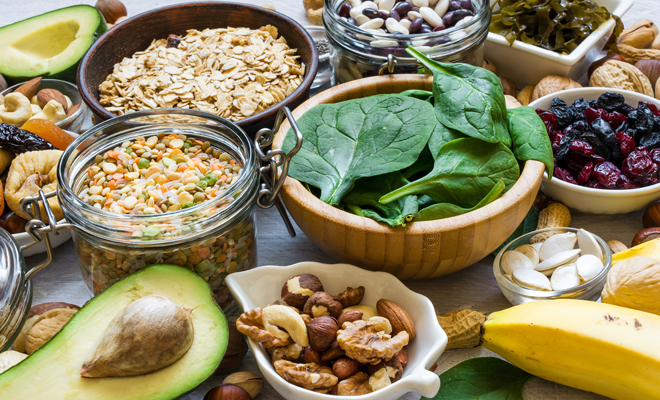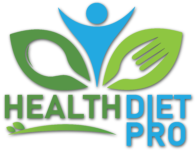Magnesium and potassium are two minerals that your body needs both to maintain a good muscular system and to build strong bones. These minerals help maintain fluid balance, nerve transmissions, and healthy blood pressure. There are a number of foods rich in both magnesium and potassium which you should eat regularly in your daily diet to have good levels in your body of these minerals and thus avoid future health problems.

What is potassium and what is it needed for?
Potassium is an electrolyte mineral found in the blood. Our organism is in charge of obtaining it fundamentally from some fruits and vegetables. It is in the small intestine where 90% is absorbed, the rest being eliminated through urine. Its accumulation is high, in fact, it is the third most abundant mineral in the entire metabolism. Among its functions is the improvement of communication between the nerves of the muscles, the circulation of nutrients in the cells and the expulsion of waste from them.
In short, potassium helps to:
- Produce proteins.
- Break down and use carbohydrates.
- Develop muscles and promote body growth.
- Regulate the level of water in the body.
- Reduce the negative effects of sodium.
- Improve and regulate the cardiovascular system.
What is magnesium and what is it needed for?
As with potassium, magnesium is also an essential mineral for the body. Its presence in the body is essential for everyone, but mainly for athletes and people with osteoporosis as it reduces tiredness and fatigue, contributes to electrolyte balance (avoiding cramps) and improves calcium absorption. Among its many benefits are the following:
- Helps metabolism by making energy reach all cells so they can fulfill their multiple functions.
- Contributes to the normal functioning of the nervous system and muscles.
- It is necessary for the maintenance of bones.
- It is a natural tranquilizer that intervenes in nerve transmissions and keeps neurons active. It has a very powerful anti-stress effect.
- It favors hormonal balance and is capable of preventing and reducing menstrual pain.
- Promotes digestion and prevents constipation.
- Prevents diabetes by making it possible to control blood sugar levels.
Foods that are rich in potassium and magnesium that you should know
Fruits and vegetables. Eating a wide variety of fruits and vegetables and including them in your daily diet can help you get the potassium and magnesium your body needs to meet its daily needs. Examples of foods that cannot be missing from your meal are: asparagus, bananas, avocados, green leafy vegetables such as spinach, broccoli orchard, melon, kiwi, tomatoes, potatoes or pumpkin.
- All these products, in addition to being rich in potassium and magnesium, are an excellent source of vitamins, minerals and fiber. Try to eat two or three pieces of fruit a day and combine it with some vegetables.
- Nuts and legumes. Nuts such as almonds, walnuts or peanuts provide high amounts of magnesium and potassium to the body. However, since they are very caloric foods, you should not exceed them and it is good that you only take the right amount to maintain good levels of potassium and magnesium in the body.
- Apart from nuts, legumes such as beans or lentils provide magnesium, potassium, minerals, fiber and proteins that are highly healthy for the body.
- Dairy and animal products. The consumption of certain dairy products such as milk, yogurt and cheese, is also another good way to increase the levels of potassium and magnesium in the body. If you are part of the people who do not tolerate dairy products, a good alternative is the intake of soy or almond milk, which are also rich in these two minerals.
- In addition, certain products of animal origin such as eggs, turkey and chicken are also responsible for providing good doses of these nutrients. If you love fish and seafood, you should know that salmon, herring, mackerel, and sardines are great options to get more magnesium and potassium.
- Cereals _ Don’t forget to include cereals such as brown rice, oatmeal or whole wheat bread in your diet. All of them are an excellent source of various vitamins and minerals such as potassium and magnesium. A good option is to include them in your daily breakfast and complement them with other products such as yogurt, dairy products or drinks, vegetable yogurts or nuts.
If you eat all these foods, your potassium and magnesium levels will be perfectly covered.
Weekly menu rich in potassium and magnesium
It is essential that we consume many foods rich in potassium and magnesium to meet the daily needs required by our body. The lack of them aggravates, among other things, fluid retention and hypertension. Next, we show you a weekly diet rich in potassium and magnesium. 100% recommended for those people who have a deficit of these two minerals!
MONDAY
- Breakfast: oatmeal porridge with banana + coffee with milk or vegetable drink.
- Mid-morning: a handful of almonds.
- Lunch: roast chicken with potatoes + cooked cabbage + seasonal fruit.
- Mid-afternoon: and Greek ogur with pumpkin seeds.
- Dinner: spinach puree + French omelette + seasonal fruit.
TUESDAY
- Breakfast: orange juice + coffee with milk or vegetable drink + turkey toast with guacamole.
- Mid-morning: 1 handful of cashews.
- Lunch: sea bream with baked potatoes and onion + seasonal fruit.
- Mid-afternoon: a chanterelle.
- Dinner: grilled tofu + baked sweet potato + cherry tomatoes + seasonal fruit.
WEDNESDAY
- Breakfast: whole rye toast with cottage cheese and tomato + coffee with milk or vegetable drink.
- Mid-morning: a kiwi.
- Lunch: beef fillet + boiled potato + mushrooms + seasonal fruit.
- Mid-afternoon: a banana.
- Dinner: grilled salmon + julienned vegetables + natural yogurt with red fruits.
THURSDAY
- Breakfast: whole wheat toast with chicken strips and baby spinach + coffee with milk or vegetable drink.
- Mid-morning: a custard apple.
- Lunch: baked chicken + whole white rice + seasonal fruit.
- Mid-afternoon: natural soy yogurt.
- Dinner: broccoli, pepper and egg stir fry + seasonal fruit.
FRIDAY
- Breakfast: porridge with a tablespoon of peanut butter and kiwi + coffee with milk or vegetable drink.
- Mid-morning: handful of almonds.
- Food: red lentil dhal with vegetables + seasonal fruit.
- Mid-afternoon: a banana.
- Dinner: baked cod + asparagus + seasonal fruit.
SATURDAY
- Breakfast: oatmeal pancakes with red fruits + coffee with milk or vegetable drink.
- Mid-morning: a chanterelle.
- Lunch: grilled egg + green beans with tomato + seasonal fruit.
- Mid-afternoon: whole wheat toast with avocado and tomato.
- Dinner: beef fillet with beetroot salad + natural yogurt.
SUNDAY
- Breakfast: banana + coffee with milk + Serrano ham toast with spread tomato.
- Mid-morning: a handful of walnuts.
- Lunch: chickpea stew with spinach and boiled egg + seasonal fruit.
- Mid-afternoon: a banana.
- Dinner: pumpkin stuffed with textured soybeans + seasonal fruit.
